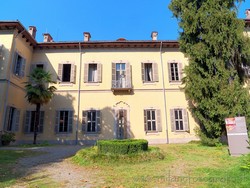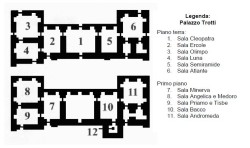|
Vimercate (Monza e Brianza, Italy): Trotti Palace
|
|
|
Show an other place around Milan worth a visit: |
 Palace Trotti was built in the mid seventeenth century by Count Giovanni Battista Secco Borella and his son Francesco, feudal lords of Vimercate, in place of an older palace. The palace, however, takes its name from that of the last owners, who took over the feud of Vimercate in 1739, having Giulia Secco Borella, sole heir, married Gianbattista Trotti. Abandoned by the owner family, the building and the adjoining park were sold to the public administration, which from 1862 transformed it into the Town Hall. Palace Trotti was built in the mid seventeenth century by Count Giovanni Battista Secco Borella and his son Francesco, feudal lords of Vimercate, in place of an older palace. The palace, however, takes its name from that of the last owners, who took over the feud of Vimercate in 1739, having Giulia Secco Borella, sole heir, married Gianbattista Trotti. Abandoned by the owner family, the building and the adjoining park were sold to the public administration, which from 1862 transformed it into the Town Hall.
Externally the building is very sober, with the facade facing the street following the course of the street. Above the main door there is a quadrangular truncated tower.
Equally sober is the side towards the park (today city park), conforming to the classic scheme of the Lombard delights villas and therefore with the typical U-shaped planimetry, although in this case the side wings are very short.
Unlike other cases, Palace Trotti has two very decorated floors, not only the ground floor as more frequently is the case.
 The element that most characterizes the palace is represented by the Baroque frescoes of mythological and legendary subject that decorate its halls. Except in one room, the one dedicated to Cleopatra where the walls are entirely frescoed, the frescoes are all located only in a large band placed immediately under the ceiling. The element that most characterizes the palace is represented by the Baroque frescoes of mythological and legendary subject that decorate its halls. Except in one room, the one dedicated to Cleopatra where the walls are entirely frescoed, the frescoes are all located only in a large band placed immediately under the ceiling.
The frescoes were painted in the course of three distinct decorative campaigns. The first decorative cycle was carried out between 1705 and 1706 and includes the frescoes in the halls of Cleopatra, of Semiramide, of Hercules and of Minerva. These frescoes were made by an artist whose name is unknown and by his workshop with a still seventeenth-century style. Their artistic value is not high, but they are in nevertheless interesting for the care and the detail with which clothes and objects are represented.
The second cycle of frescoes includes only those of the so-called Hall of Bacchus, painted between 1710 and 1715 by Carlo Donelli, known as Vimercati. Their artistic value is significantly higher.
The third decorative cycle dates back to 1750 and includes the decorations of the halls of Olympus, of Atalanta, of Diana (or of the Moon), of Angelica and Medoro, of Pyramus and Thisbe and that of Andromeda. The author of this third cycle is Antonio Orelli, one of the greatest interpreters of the Lombard rococo.
In addition to the numerous frescoes, Palace Trotti is also characterized by the presence of beautiful painted ceilings, of an important paintings collection with numerous portraits of various past owners of the building, of various rococo fireplaces and precious furnishings. In fact Palazzo Trotti can be considered one of the best examples of noble residence of the eighteenth-century Lombardy.
Brief description of the halls:
Hall of Cleopatra (Fig. 1): It is the only room with entirely frescoed walls. In it the trompe l'oeil technique was widely used.
Between the doors and windows there are fake niches with fake statues representing Fame, Justice, Harmony, Grace, Prosperity and Power. Above the doors there are the allegories of the arts Painting, Sculpture, Music and Mathematics within stucco ovals. The number 1705, the year of realization of the frescoes in the hall, can be recognized in the table that the last one holds in ers hands.
In the upper part, within late baroque frames, episodes from the life of Cleopatra: Cleopatra at a banquet with Marcus Antonius, Cleopatra and Marcus Antonius receiving the Roman ambassadors who recall the second in his homeland, the departure on horseback of Cleopatra and, finally, her suicide.
Hall of Semiramide: The frescoes tell the war enterprises and the architectural achievements of the queen of the Assyrians. In the room there is also a beautiful marble fireplace dominated by a rococo mirror and numerous paintings, including various portraits of children from the Secco Borella and Trotti families.
Hall of Herkules: In it are represented four episodes of the life of Hercules.
Hall of Minerva (Fig. 4): Of the rooms of the first cycle it is that in which the artistic quality is lower, more, however, from a point of view of the accuracy of the representations, because the color choices are nevertheless guessed and of great impact. In Fig. 4 Minerva goddess of peace.
Room of Olympus: It hosts beautiful mythological-themed scenes painted by Orelli, in particular banquets of gods and goddesses of Olympus, probably according to the original function of the hall. In the hall there are also an eighteenth-century fireplace and various portraits.
Hall di Diana or of the Moon: It contains scenes painted by Orelli and dedicated to the myth of Endymion, a shepherd who received every night while he slept, the visit of the goddess who contemplated him and kissed him in his sleep.
Hall of Atalanta (Fig. 1): It tells the story of Atalanta, an nymph unbeatable in race but which at the end, thanks to a trick put in place by Venus (letting her find gold apples on the route of the race), is beaten by one of his suitors, who so manages to have her hand.
Hall of Angelica and Medoro: The love story with a happy ending between Angelica and Medoro is told.
Hall of Piramo and Tisbe: In it is instead depicted a love story with a tragic ending. In fact, Piramo finds the bloody veil of his beloved, attacked by a lion, and, convinced that she has been torn to pieces, he kills himself. When Tisbe, who had managed to save herself, finds the body of the beloved she kills herself too.
Hall of Andromeda and Perseus: It shows the story of love, here again one with a happy ending, between Andromeda and Perseus.
Hall of Bacchus: The frescoes of Vimercati, dedicated to pleasure, beauty and sensuality, are high-level, very modern for the time, indeed anticipatory in the use of light, and characterized by well-modeled figures, daring views and clear and spacious skies as background.
Categories: Places of historical value of artistic value
Piazza Unità d'Italia, 1, 20871 Vimercate MB |
Further pictures of Trotti Palace in the section Photography |